Big Data Analytics: Techniques, Challenges and Business Support
VerifiedAdded on 2023/06/09
|8
|2089
|81
AI Summary
This report discusses the characteristics of Big Data, the challenges faced by organizations while managing Big Data, the techniques currently available to analyze Big Data, and how Big Data technology could support businesses with examples. The report also includes a poster and references.
Contribute Materials
Your contribution can guide someone’s learning journey. Share your
documents today.
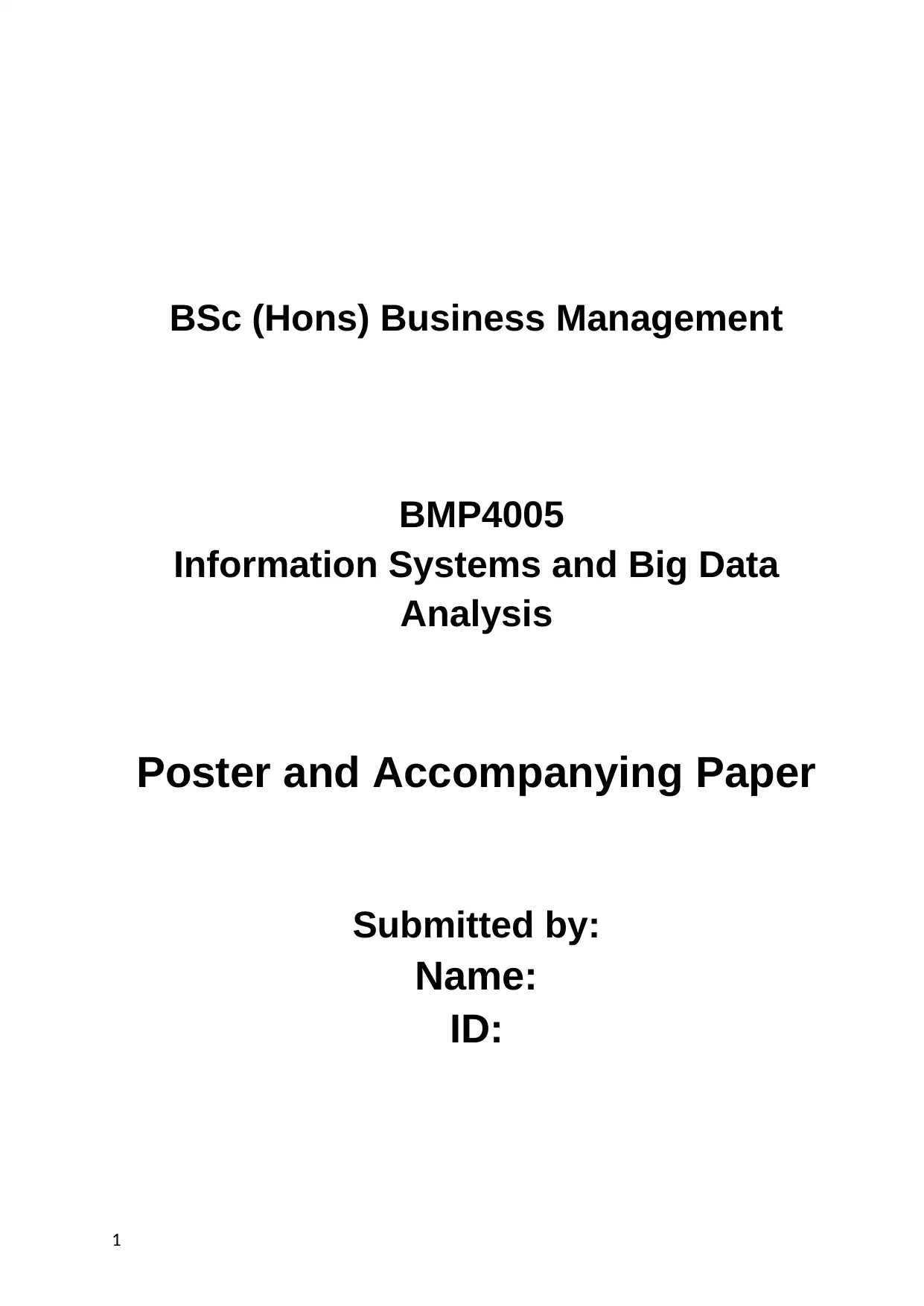
BSc (Hons) Business Management
BMP4005
Information Systems and Big Data
Analysis
Poster and Accompanying Paper
Submitted by:
Name:
ID:
1
BMP4005
Information Systems and Big Data
Analysis
Poster and Accompanying Paper
Submitted by:
Name:
ID:
1
Secure Best Marks with AI Grader
Need help grading? Try our AI Grader for instant feedback on your assignments.

Contents
Introduction p
What big data is and the characteristics of big data p
The challenges of big data analytics p
The techniques that are currently available to analyse big data
p
How Big Data technology could support business, an explanation
with examples p
Poster p
References p
2
Introduction p
What big data is and the characteristics of big data p
The challenges of big data analytics p
The techniques that are currently available to analyse big data
p
How Big Data technology could support business, an explanation
with examples p
Poster p
References p
2

Introduction
Data is the most valuable asset in today's world. Management of sets of data
is large and complex which ise stored in the softwares. It is inadequate to capture
and manage the data within a particular amount of time. It is a combination of
structured and unstructured data gathered by the organizations which is used for
various projects and applications. In this report, there is a discussion of what big
data is along with its characteristics. This report also discuss the issues and
challenges of big data and various techniques which are available to analyse big
data and an explanation of the support given by big data technology to business
with examples.
What big data is and the characteristics of big data
Big data involves large volumes of data which are too complex and hard to
manage within a reasonable amount of time. Big data can be used for gathering
various information beneficial for the organizations. In simple words, complex and
larger sets of data, especially from new data sources is referred to as big data. It is
generally categorized into three categories- structured, unstructured and semi-
structured. Characteristics of Big Data is often described as 5v's, namely, volume,
value, variety, velocity and veracity. A brief discussion of them is given below:
Volume – Volume is about the space and stoarge which is presented in the
sftware for keeping iformtaion. It is generated from sources such as social
media, images, videos, cellphones, etc. Instagram alone generate billion
messages each day. Such a large amount of data can be managed by Big
Data Technologies only.
Value – Value is one of the most important issue for an organization to focus
on. It is not just the amount of data rather it is the amount of valuable and
trustworthy data that is stored or processed. Value is the amount of data
reliability.
Variety – Different types of big data are generated. Variety refers to those
types of Big data. It is important for the organization to manage the variety of
its data. The latest trend of data is in the form of images, videos, audio, etc.,
making a large portion of the data unstructured.
3
Data is the most valuable asset in today's world. Management of sets of data
is large and complex which ise stored in the softwares. It is inadequate to capture
and manage the data within a particular amount of time. It is a combination of
structured and unstructured data gathered by the organizations which is used for
various projects and applications. In this report, there is a discussion of what big
data is along with its characteristics. This report also discuss the issues and
challenges of big data and various techniques which are available to analyse big
data and an explanation of the support given by big data technology to business
with examples.
What big data is and the characteristics of big data
Big data involves large volumes of data which are too complex and hard to
manage within a reasonable amount of time. Big data can be used for gathering
various information beneficial for the organizations. In simple words, complex and
larger sets of data, especially from new data sources is referred to as big data. It is
generally categorized into three categories- structured, unstructured and semi-
structured. Characteristics of Big Data is often described as 5v's, namely, volume,
value, variety, velocity and veracity. A brief discussion of them is given below:
Volume – Volume is about the space and stoarge which is presented in the
sftware for keeping iformtaion. It is generated from sources such as social
media, images, videos, cellphones, etc. Instagram alone generate billion
messages each day. Such a large amount of data can be managed by Big
Data Technologies only.
Value – Value is one of the most important issue for an organization to focus
on. It is not just the amount of data rather it is the amount of valuable and
trustworthy data that is stored or processed. Value is the amount of data
reliability.
Variety – Different types of big data are generated. Variety refers to those
types of Big data. It is important for the organization to manage the variety of
its data. The latest trend of data is in the form of images, videos, audio, etc.,
making a large portion of the data unstructured.
3

Velocity – Velocity refers to the speed of data processing and has a major
role. The prime aspect of Big data is to provide information on demand at a
faster pace otherwise it will be useless for the organization to invest so much
on the process.
Veracity – Veracity refers to the accuracy or the reliability of the data. It is
quite a significant characteristic as low veracity can highly affect the results of
the process of organization.
The challenges of big data analytics
There are various challenges faced by an organization while managing Big
data. These challenges are known as Big Data Challenges and must be taken care
of. These challenges includes the best way to deal with a large amount of data,
involving the process of storing and analyzing. Some of the challenges are
discussed below:
Lack of Knowledgeable Professionals - Data scientist, data analyst and data
engineers are skilled professionals that are required by the organizations to
run the modern technologies and large data tools. Lack of these
professionals is the biggest challenge faced by the organizations.
Securing data - Securing one's data is a massive challenge in today's world.
Companies are so busy in the process of storing and analyzing data sets
that they almost neglect or push their security. Companies should invest on
recruiting cybersecurity professionals.
Lack of Understanding of Massive Data - Insufficient understanding is the
cause behind the failure of companies in their Big Data initiatives.
Employees may not know the importance of storage and as a result, data
can't be retrieved easily when required.
Integrating Data from a Spread of Sources - Organizations collect data from
various sources. Integrating and organizing the assigned data in a report
might be a challenging task. Data integration tools like Xplenty, CloverDX,
etc., are purchased by companies to deal with this challenge.
Confusion while selection of Big Data Tool - Big Data tool selection is quite a
challenging task for companies as they often get confused while selecting
4
role. The prime aspect of Big data is to provide information on demand at a
faster pace otherwise it will be useless for the organization to invest so much
on the process.
Veracity – Veracity refers to the accuracy or the reliability of the data. It is
quite a significant characteristic as low veracity can highly affect the results of
the process of organization.
The challenges of big data analytics
There are various challenges faced by an organization while managing Big
data. These challenges are known as Big Data Challenges and must be taken care
of. These challenges includes the best way to deal with a large amount of data,
involving the process of storing and analyzing. Some of the challenges are
discussed below:
Lack of Knowledgeable Professionals - Data scientist, data analyst and data
engineers are skilled professionals that are required by the organizations to
run the modern technologies and large data tools. Lack of these
professionals is the biggest challenge faced by the organizations.
Securing data - Securing one's data is a massive challenge in today's world.
Companies are so busy in the process of storing and analyzing data sets
that they almost neglect or push their security. Companies should invest on
recruiting cybersecurity professionals.
Lack of Understanding of Massive Data - Insufficient understanding is the
cause behind the failure of companies in their Big Data initiatives.
Employees may not know the importance of storage and as a result, data
can't be retrieved easily when required.
Integrating Data from a Spread of Sources - Organizations collect data from
various sources. Integrating and organizing the assigned data in a report
might be a challenging task. Data integration tools like Xplenty, CloverDX,
etc., are purchased by companies to deal with this challenge.
Confusion while selection of Big Data Tool - Big Data tool selection is quite a
challenging task for companies as they often get confused while selecting
4
Secure Best Marks with AI Grader
Need help grading? Try our AI Grader for instant feedback on your assignments.
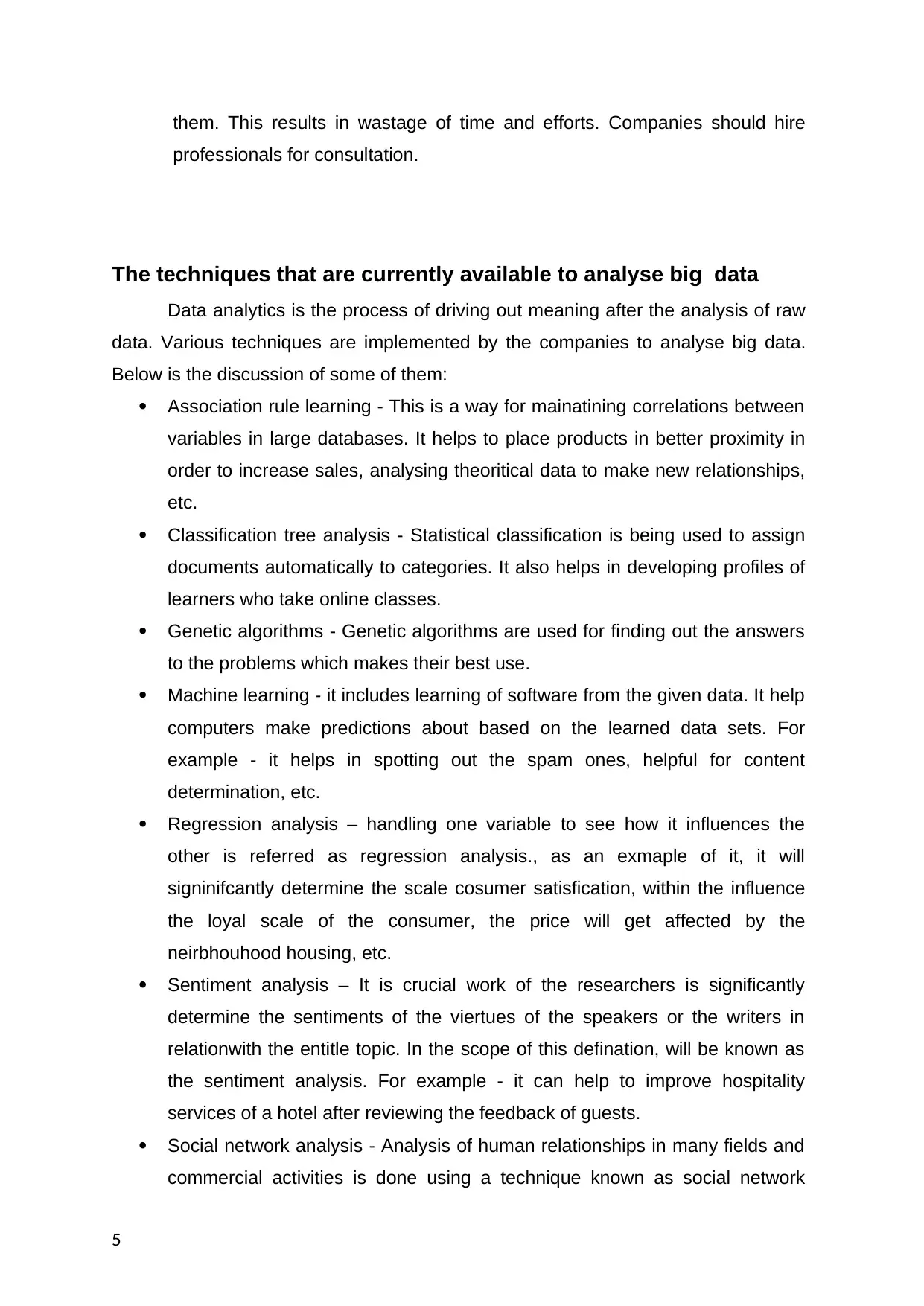
them. This results in wastage of time and efforts. Companies should hire
professionals for consultation.
The techniques that are currently available to analyse big data
Data analytics is the process of driving out meaning after the analysis of raw
data. Various techniques are implemented by the companies to analyse big data.
Below is the discussion of some of them:
Association rule learning - This is a way for mainatining correlations between
variables in large databases. It helps to place products in better proximity in
order to increase sales, analysing theoritical data to make new relationships,
etc.
Classification tree analysis - Statistical classification is being used to assign
documents automatically to categories. It also helps in developing profiles of
learners who take online classes.
Genetic algorithms - Genetic algorithms are used for finding out the answers
to the problems which makes their best use.
Machine learning - it includes learning of software from the given data. It help
computers make predictions about based on the learned data sets. For
example - it helps in spotting out the spam ones, helpful for content
determination, etc.
Regression analysis – handling one variable to see how it influences the
other is referred as regression analysis., as an exmaple of it, it will
signinifcantly determine the scale cosumer satisfication, within the influence
the loyal scale of the consumer, the price will get affected by the
neirbhouhood housing, etc.
Sentiment analysis – It is crucial work of the researchers is significantly
determine the sentiments of the viertues of the speakers or the writers in
relationwith the entitle topic. In the scope of this defination, will be known as
the sentiment analysis. For example - it can help to improve hospitality
services of a hotel after reviewing the feedback of guests.
Social network analysis - Analysis of human relationships in many fields and
commercial activities is done using a technique known as social network
5
professionals for consultation.
The techniques that are currently available to analyse big data
Data analytics is the process of driving out meaning after the analysis of raw
data. Various techniques are implemented by the companies to analyse big data.
Below is the discussion of some of them:
Association rule learning - This is a way for mainatining correlations between
variables in large databases. It helps to place products in better proximity in
order to increase sales, analysing theoritical data to make new relationships,
etc.
Classification tree analysis - Statistical classification is being used to assign
documents automatically to categories. It also helps in developing profiles of
learners who take online classes.
Genetic algorithms - Genetic algorithms are used for finding out the answers
to the problems which makes their best use.
Machine learning - it includes learning of software from the given data. It help
computers make predictions about based on the learned data sets. For
example - it helps in spotting out the spam ones, helpful for content
determination, etc.
Regression analysis – handling one variable to see how it influences the
other is referred as regression analysis., as an exmaple of it, it will
signinifcantly determine the scale cosumer satisfication, within the influence
the loyal scale of the consumer, the price will get affected by the
neirbhouhood housing, etc.
Sentiment analysis – It is crucial work of the researchers is significantly
determine the sentiments of the viertues of the speakers or the writers in
relationwith the entitle topic. In the scope of this defination, will be known as
the sentiment analysis. For example - it can help to improve hospitality
services of a hotel after reviewing the feedback of guests.
Social network analysis - Analysis of human relationships in many fields and
commercial activities is done using a technique known as social network
5
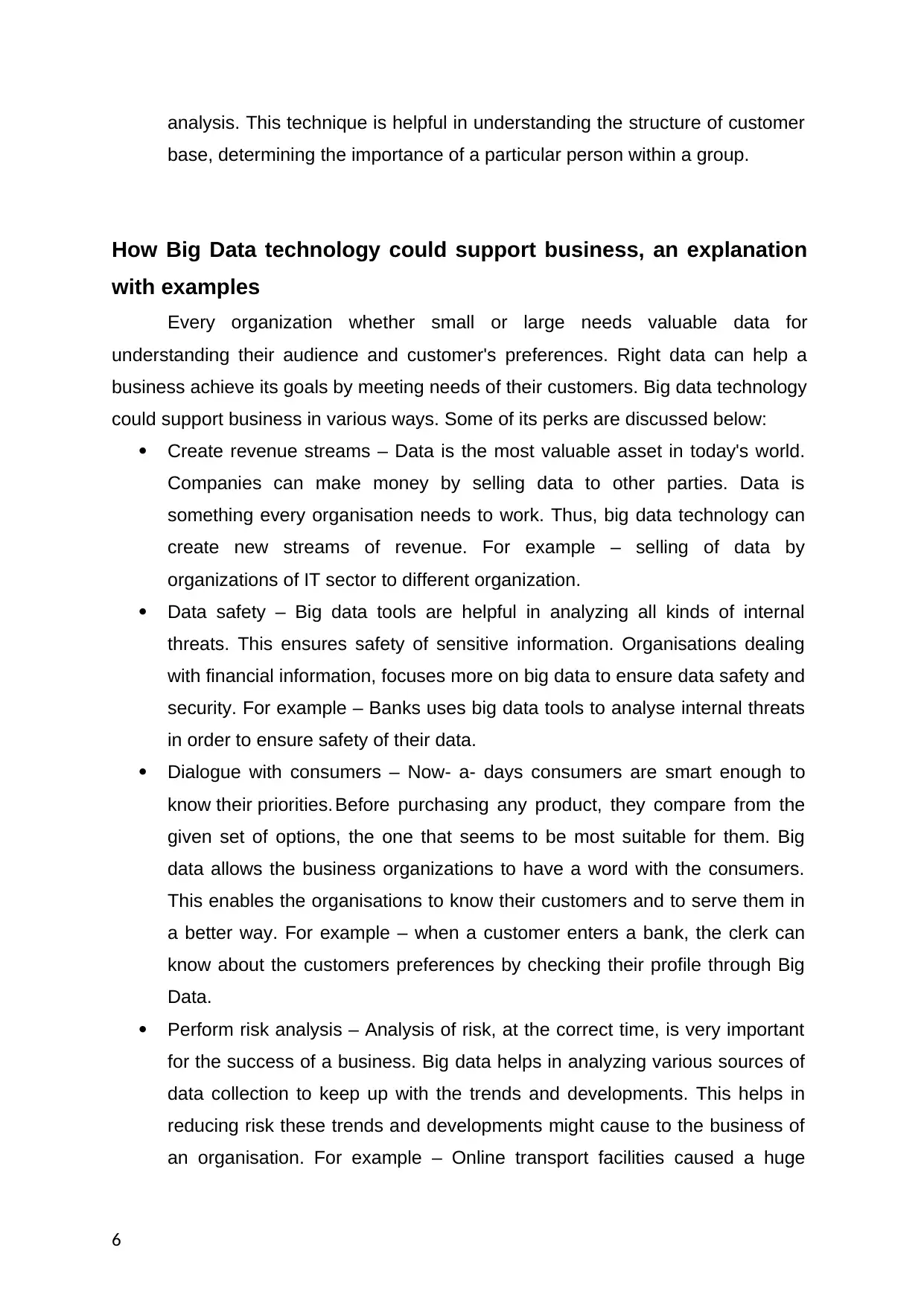
analysis. This technique is helpful in understanding the structure of customer
base, determining the importance of a particular person within a group.
How Big Data technology could support business, an explanation
with examples
Every organization whether small or large needs valuable data for
understanding their audience and customer's preferences. Right data can help a
business achieve its goals by meeting needs of their customers. Big data technology
could support business in various ways. Some of its perks are discussed below:
Create revenue streams – Data is the most valuable asset in today's world.
Companies can make money by selling data to other parties. Data is
something every organisation needs to work. Thus, big data technology can
create new streams of revenue. For example – selling of data by
organizations of IT sector to different organization.
Data safety – Big data tools are helpful in analyzing all kinds of internal
threats. This ensures safety of sensitive information. Organisations dealing
with financial information, focuses more on big data to ensure data safety and
security. For example – Banks uses big data tools to analyse internal threats
in order to ensure safety of their data.
Dialogue with consumers – Now- a- days consumers are smart enough to
know their priorities. Before purchasing any product, they compare from the
given set of options, the one that seems to be most suitable for them. Big
data allows the business organizations to have a word with the consumers.
This enables the organisations to know their customers and to serve them in
a better way. For example – when a customer enters a bank, the clerk can
know about the customers preferences by checking their profile through Big
Data.
Perform risk analysis – Analysis of risk, at the correct time, is very important
for the success of a business. Big data helps in analyzing various sources of
data collection to keep up with the trends and developments. This helps in
reducing risk these trends and developments might cause to the business of
an organisation. For example – Online transport facilities caused a huge
6
base, determining the importance of a particular person within a group.
How Big Data technology could support business, an explanation
with examples
Every organization whether small or large needs valuable data for
understanding their audience and customer's preferences. Right data can help a
business achieve its goals by meeting needs of their customers. Big data technology
could support business in various ways. Some of its perks are discussed below:
Create revenue streams – Data is the most valuable asset in today's world.
Companies can make money by selling data to other parties. Data is
something every organisation needs to work. Thus, big data technology can
create new streams of revenue. For example – selling of data by
organizations of IT sector to different organization.
Data safety – Big data tools are helpful in analyzing all kinds of internal
threats. This ensures safety of sensitive information. Organisations dealing
with financial information, focuses more on big data to ensure data safety and
security. For example – Banks uses big data tools to analyse internal threats
in order to ensure safety of their data.
Dialogue with consumers – Now- a- days consumers are smart enough to
know their priorities. Before purchasing any product, they compare from the
given set of options, the one that seems to be most suitable for them. Big
data allows the business organizations to have a word with the consumers.
This enables the organisations to know their customers and to serve them in
a better way. For example – when a customer enters a bank, the clerk can
know about the customers preferences by checking their profile through Big
Data.
Perform risk analysis – Analysis of risk, at the correct time, is very important
for the success of a business. Big data helps in analyzing various sources of
data collection to keep up with the trends and developments. This helps in
reducing risk these trends and developments might cause to the business of
an organisation. For example – Online transport facilities caused a huge
6
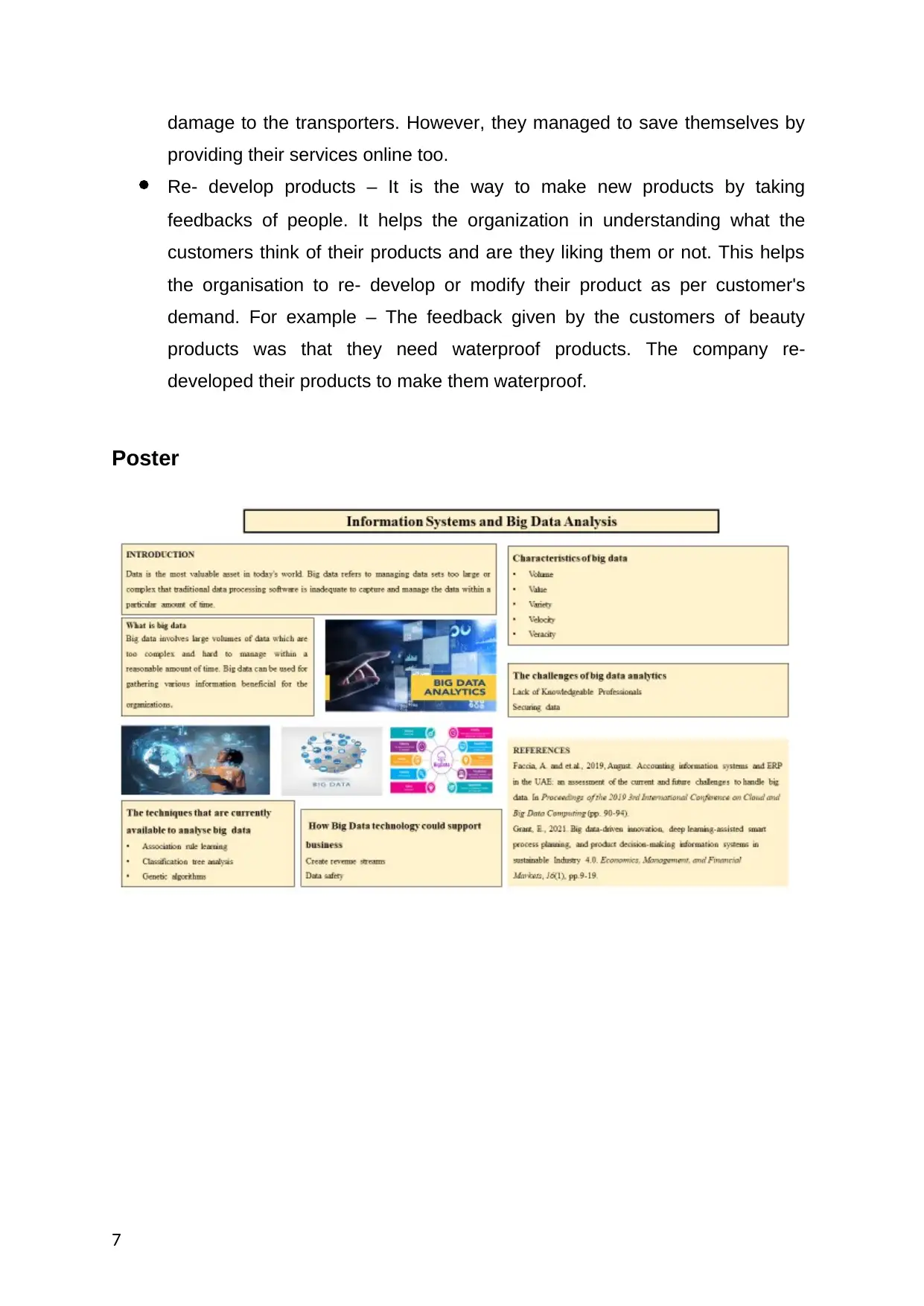
damage to the transporters. However, they managed to save themselves by
providing their services online too.
Re- develop products – It is the way to make new products by taking
feedbacks of people. It helps the organization in understanding what the
customers think of their products and are they liking them or not. This helps
the organisation to re- develop or modify their product as per customer's
demand. For example – The feedback given by the customers of beauty
products was that they need waterproof products. The company re-
developed their products to make them waterproof.
Poster
7
providing their services online too.
Re- develop products – It is the way to make new products by taking
feedbacks of people. It helps the organization in understanding what the
customers think of their products and are they liking them or not. This helps
the organisation to re- develop or modify their product as per customer's
demand. For example – The feedback given by the customers of beauty
products was that they need waterproof products. The company re-
developed their products to make them waterproof.
Poster
7
Paraphrase This Document
Need a fresh take? Get an instant paraphrase of this document with our AI Paraphraser
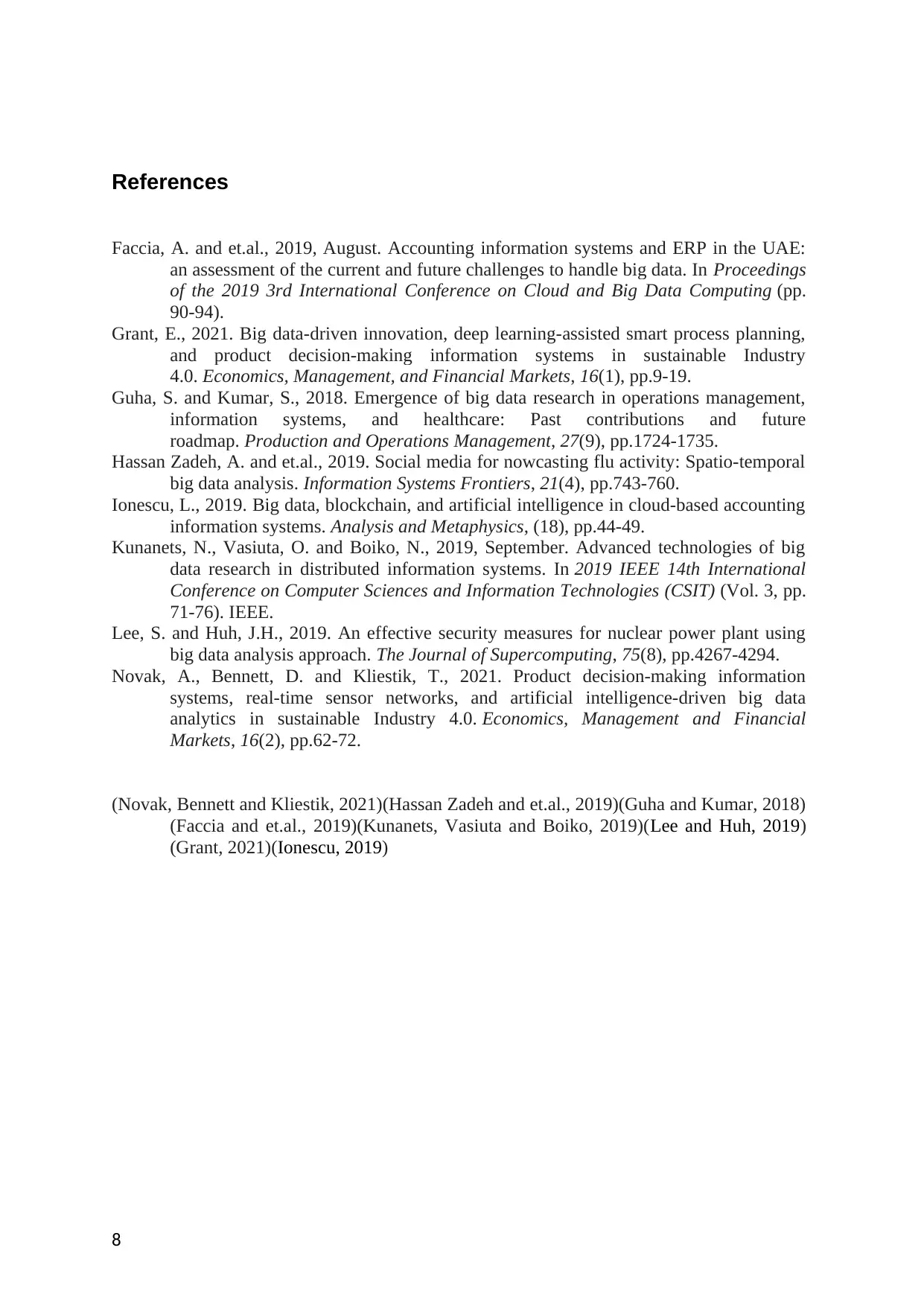
References
Faccia, A. and et.al., 2019, August. Accounting information systems and ERP in the UAE:
an assessment of the current and future challenges to handle big data. In Proceedings
of the 2019 3rd International Conference on Cloud and Big Data Computing (pp.
90-94).
Grant, E., 2021. Big data-driven innovation, deep learning-assisted smart process planning,
and product decision-making information systems in sustainable Industry
4.0. Economics, Management, and Financial Markets, 16(1), pp.9-19.
Guha, S. and Kumar, S., 2018. Emergence of big data research in operations management,
information systems, and healthcare: Past contributions and future
roadmap. Production and Operations Management, 27(9), pp.1724-1735.
Hassan Zadeh, A. and et.al., 2019. Social media for nowcasting flu activity: Spatio-temporal
big data analysis. Information Systems Frontiers, 21(4), pp.743-760.
Ionescu, L., 2019. Big data, blockchain, and artificial intelligence in cloud-based accounting
information systems. Analysis and Metaphysics, (18), pp.44-49.
Kunanets, N., Vasiuta, O. and Boiko, N., 2019, September. Advanced technologies of big
data research in distributed information systems. In 2019 IEEE 14th International
Conference on Computer Sciences and Information Technologies (CSIT) (Vol. 3, pp.
71-76). IEEE.
Lee, S. and Huh, J.H., 2019. An effective security measures for nuclear power plant using
big data analysis approach. The Journal of Supercomputing, 75(8), pp.4267-4294.
Novak, A., Bennett, D. and Kliestik, T., 2021. Product decision-making information
systems, real-time sensor networks, and artificial intelligence-driven big data
analytics in sustainable Industry 4.0. Economics, Management and Financial
Markets, 16(2), pp.62-72.
(Novak, Bennett and Kliestik, 2021)(Hassan Zadeh and et.al., 2019)(Guha and Kumar, 2018)
(Faccia and et.al., 2019)(Kunanets, Vasiuta and Boiko, 2019)(Lee and Huh, 2019)
(Grant, 2021)(Ionescu, 2019)
8
Faccia, A. and et.al., 2019, August. Accounting information systems and ERP in the UAE:
an assessment of the current and future challenges to handle big data. In Proceedings
of the 2019 3rd International Conference on Cloud and Big Data Computing (pp.
90-94).
Grant, E., 2021. Big data-driven innovation, deep learning-assisted smart process planning,
and product decision-making information systems in sustainable Industry
4.0. Economics, Management, and Financial Markets, 16(1), pp.9-19.
Guha, S. and Kumar, S., 2018. Emergence of big data research in operations management,
information systems, and healthcare: Past contributions and future
roadmap. Production and Operations Management, 27(9), pp.1724-1735.
Hassan Zadeh, A. and et.al., 2019. Social media for nowcasting flu activity: Spatio-temporal
big data analysis. Information Systems Frontiers, 21(4), pp.743-760.
Ionescu, L., 2019. Big data, blockchain, and artificial intelligence in cloud-based accounting
information systems. Analysis and Metaphysics, (18), pp.44-49.
Kunanets, N., Vasiuta, O. and Boiko, N., 2019, September. Advanced technologies of big
data research in distributed information systems. In 2019 IEEE 14th International
Conference on Computer Sciences and Information Technologies (CSIT) (Vol. 3, pp.
71-76). IEEE.
Lee, S. and Huh, J.H., 2019. An effective security measures for nuclear power plant using
big data analysis approach. The Journal of Supercomputing, 75(8), pp.4267-4294.
Novak, A., Bennett, D. and Kliestik, T., 2021. Product decision-making information
systems, real-time sensor networks, and artificial intelligence-driven big data
analytics in sustainable Industry 4.0. Economics, Management and Financial
Markets, 16(2), pp.62-72.
(Novak, Bennett and Kliestik, 2021)(Hassan Zadeh and et.al., 2019)(Guha and Kumar, 2018)
(Faccia and et.al., 2019)(Kunanets, Vasiuta and Boiko, 2019)(Lee and Huh, 2019)
(Grant, 2021)(Ionescu, 2019)
8
1 out of 8
Related Documents
Your All-in-One AI-Powered Toolkit for Academic Success.
+13062052269
info@desklib.com
Available 24*7 on WhatsApp / Email
![[object Object]](/_next/static/media/star-bottom.7253800d.svg)
Unlock your academic potential
© 2024 | Zucol Services PVT LTD | All rights reserved.

